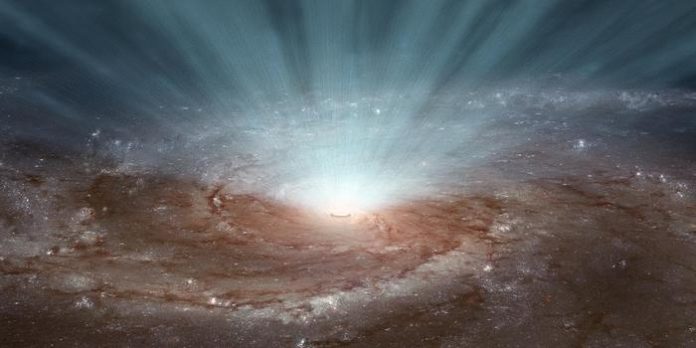
Mysterious, ultra-high-energy cosmic rays have confused scientists for decades. Now, new research from Norway suggests supermassive black holes and their powerful winds might be the long-sought cosmic accelerators behind these extraordinary particles
For decades, a fundamental mystery has puzzled physicists: the origin of ultra-high-energy cosmic rays. These minuscule particles, primarily atomic nuclei, hurtle through the universe at astounding speeds, carrying energies far exceeding anything scientists can generate on Earth. While cosmic rays themselves are a known phenomenon, the source of these exceptionally energetic ones has remained elusive since their discovery in 1962. Now, groundbreaking research from the Norwegian University of Science and Technology (NTNU) offers a compelling new hypothesis, suggesting that supermassive black holes could be the culprits.
The black hole connection
The universe is awash with various forms of radiation and particles, from photons across the electromagnetic spectrum to neutrinos and cosmic rays. Cosmic rays, despite their misleading name, are actually particles accelerated to immense energies by some of the most extreme environments in the cosmos, such as black holes, supernovae, or rotating neutron stars. However, the origin of their ultra-high-energy counterparts has been a persistent riddle.
A team of astroparticle physicists from NTNU’s Department of Physics, led by Associate Professor Foteini Oikonomou, along with PhD research fellow Domenik Ehlert and postdoctoral fellow Enrico Peretti from Université Paris Cité, has proposed a novel explanation. Their work, focusing on the intricate relationship between the universe’s smallest particles and its largest phenomena, points towards the powerful winds emanating from supermassive black holes.
“We suspect that this high-energy radiation is created by winds from supermassive black holes,” states Oikonomou.
Active black holes and their collosal winds
Our Milky Way galaxy, home to billions of stars including our Sun, harbors a supermassive black hole at its center known as Sagittarius A*. Currently in a quiescent phase, it’s not actively consuming matter. This contrasts sharply with “active” supermassive black holes, which can devour stellar material equivalent to several times the mass of our Sun each year.
“A tiny portion of the material can be pushed away by the force of the black hole before it is pulled in,” explains Peretti. “As a result, around half of these supermassive black holes create winds that move through the universe at up to half the speed of light.”
These colossal winds, known to science for approximately a decade, exert a significant influence on galaxies, capable of sweeping away gases and inhibiting the formation of new stars. However, Oikonomou and her colleagues have turned their attention to a much smaller, yet far more energetic, consequence of these winds. “It is possible that these powerful winds accelerate the particles that create the ultra-high-energy radiation,” suggests Ehlert.
Enormous energies in microscopic particles
The ultra-high-energy radiation under investigation consists of protons or atomic nuclei possessing an astounding 1020 electron volts of energy. To put this into perspective, Oikonomou illustrates, “A particle like this, which is smaller than an atom, contains about as much energy as a tennis ball when Serena Williams serves it at 200 kilometers per hour.” This is roughly a billion times more energy than particles generated in the Large Hadron Collider.
Fortunately, these cosmic rays are largely neutralised by Earth’s atmosphere, rendering them harmless by the time they reach ground level. However, for astronauts, cosmic radiation poses a significant concern. While the primary concern for space travelers is the more frequent, lower-energy radiation from our Sun, the extreme rarity of these ultra-high-energy rays makes a direct hit on an astronaut incredibly unlikely.
Ruling Out Other Suspects and a Cautious “Maybe”
Previous theories for the origin of these elusive particles included gamma-ray bursts, galaxies with extremely high star formation rates, and plasma outflows from supermassive black holes. However, as Ehlert explains, “All the other hypotheses are very good guesses – they are all sources that contain a lot of energy. But no one has provided evidence that any of them are the source. That is why we decided to investigate the winds from the supermassive black holes.”
While the NTNU team’s findings are promising, Oikonomou offers a measured response to the question of definitive proof. “Our answer is more of a cautious ‘maybe’,” she states, emphasizing that while “the conditions related to these winds align particularly well with particle acceleration,” conclusive proof is still pending.
Crucially, their model offers a unique advantage: it can explain the puzzling chemical composition of these particles within a specific energy range, a feat other models have struggled with. The researchers are eager to collaborate with neutrino astronomers in the coming years, hoping to test their hypothesis further through neutrino experiments. This next step could provide crucial evidence to either confirm or refute the role of supermassive black hole winds in generating the universe’s most energetic cosmic rays.










